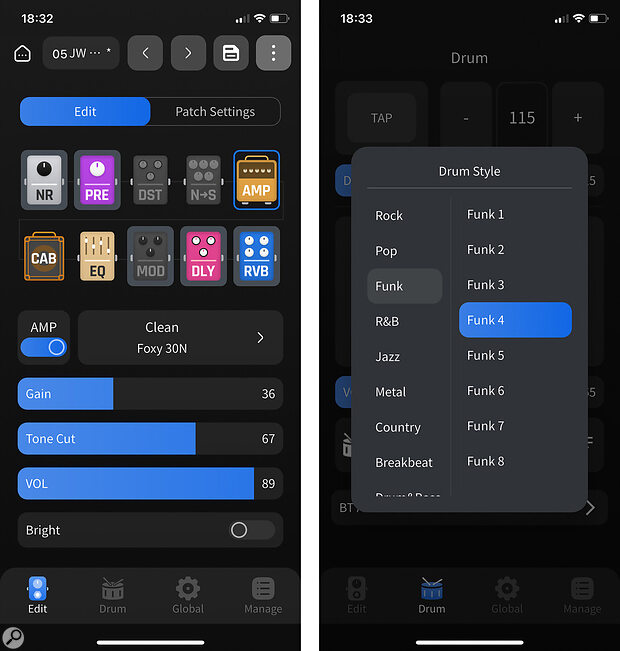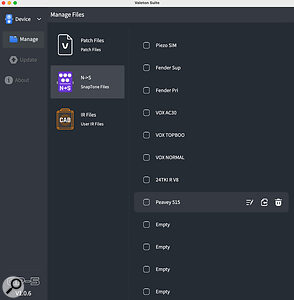 The Valeton GP‑5: an entire guitar rig that fits in your pocket.
The Valeton GP‑5: an entire guitar rig that fits in your pocket.
Can this pocket‑sized, pocket‑money guitar rig really deliver the goods? You might be surprised...
While Valeton might not have quite the same profile as the likes of Line 6, Fractal, Neural DSP or Kemper, their GP series has been quietly flying slightly below the radar, and has now developed into a very impressive line of guitar amp modellers, profilers and multi‑effects devices that punch well above their asking price.
The latest in this line is the diminutive GP‑5: while it comes in a tiny mini‑pedal format, it has a frankly amazing feature list, and a very modest price tag too. That list includes amp and cab modelling, the ability to use amp‑plus‑cab captures, effects modelling, a customisable signal chain, a rather nice collection of genre‑based drum loops, and a mobile app (for both iOS and Android) for easy editing and control over all these features. But is the idea of squeezing an entire guitar (or bass) rig into a pocket‑sized pedal like this too good to be true? Time to plug in and find out...
Guitar Rig TARDIS
The GP‑5 offers a standard quarter‑inch jack instrument input and a multi‑function mono/stereo output, again on quarter‑inch jack This can be used to feed other pedals or an amp, or to provide a stereo output for a mixer/PA or even for headphones. A well‑written PDF manual does an excellent job of explaining the various configuration options, and these would cover almost any eventuality, from headphone practice through to various live‑performance scenarios. The back panel has both a standard 9V power inlet and a USB‑C port, and the latter facilitates firmware and file import options, as well as serving as a basic audio interface for recording.
On the top panel, you get a dedicated volume knob along with a multi‑function push‑turn Parameter encoder. This allows you to switch patches, edit some settings and turn the wireless Bluetooth connectivity on (more on this shortly). The tiny LCD screen shows patch names and numbers, indicates the Bluetooth status, and, if you long‑press the single footswitch, provides access to a simple but effective tuner. The footswitch itself can be used in three different modes: to step forwards through the 100 patch slots; turn effects on/off; or as a global bypass. The provision of only a single footswitch here is understandable given the compact format, but if I had one gripe it’s that there’s no mode that simply lets you toggle back and forth between two adjacent patches. This would enable easy switching between, say, a rhythm and lead tone for a specific song, for example. Something for a future firmware update? Having said that, there is a Song List mode, so if your gig set list is pre‑organised you could sequence patches within the GP‑5 and simply step through that list.
An App For That
For patch editing, the dedicated mobile app (which is free to download) is essential. It connects easily to the GP‑5 over Bluetooth and, as shown in the screenshot, its very intuitive UI allows you to select patches and edit all the elements in your signal chain. This includes the various effects slots: NR (noise reduction); Pre (preamp/boost style pedals); Dst (overdrive and distortion); EQ; Mod (various chorus, phaser and flanger options); Dly and Rvb. Within any patch, in each slot, you can pick one of the available pedal options; again, these are properly documented in the PDF manual. You can also reorder the signal chain by simply dragging and dropping within the GUI.
 The free‑to‑download mobile app is an essential part of the overall GP‑5 package. It includes a good selection of drum loops for personal practice, and these can be streamed to the GP‑5 via Bluetooth.
The free‑to‑download mobile app is an essential part of the overall GP‑5 package. It includes a good selection of drum loops for personal practice, and these can be streamed to the GP‑5 via Bluetooth.
The Amp and Cab modules provide modelling‑based options and cover lots of classic amp/cab targets, including clean to high‑gain choices as well as a number of options for bass. As with the effects, each amp model offers a small number of editable parameters such as volume, gain and EQ. The two modules can be switched on/off independently so, for example, if the GP‑5 signal were to be sent through an actual guitar cab, you could disable the Cab module. The Cab module also supports IR loading, by the way, with 20 slots available for user files.
Valeton’s SnapTone technology lets you import captures from the open‑source Neural Amp Modeler software..
The N‑S module provides amp/cab profile capabilities using Valeton’s SnapTone technology that lets you import captures from the open‑source Neural Amp Modeler software. The GP‑5 ships with a decent selection of 50 factory presets already, but with 80 slots available in total, you can load more, for example from the Tone3000 website, and when connected over USB to a computer you can use Valeton’s Mac/Windows software to manage this process. Note that if you enable the N‑S module, the Amp and Cab modules are automatically bypassed. I’m not sure if this is a processing power limitation but, even if not, it’s a common‑sense feature to avoid the potential sonic chaos of ‘amp/cab into amp/cab’.
 A MacOS/Windows app makes it easy to manage and import amp/cap captures/IRs to the GP‑5.
A MacOS/Windows app makes it easy to manage and import amp/cap captures/IRs to the GP‑5.
Just for good measure, the app also offers a pretty impressive selection of tempo‑adjustable genre‑based drum loops, and if you link your GP‑5 to your phone as a Bluetooth audio device, you can hear the drums over the GP‑5’s output and blend them with your guitar signal. Used with headphones, it makes for an excellent ‘silent’ practice platform.
Small Size, Big Sound
The GP‑5’s extensive feature list and compact cuteness are impressive but, wonderfully, they’re matched by some truly excellent guitar tones. As we now expect from almost any modeller/capture device, you have plenty of choices, spanning a wide range of guitar tones and musical styles. There are amps inspired by classic clean platforms by Fender, crunchy options for a selection of Vox or classic Marshall‑style tones, and a good selection of amp styles aimed at higher‑gain rock and metal (think modern Marshall, Mesa, Peavey and others). In short, there’s something for everyone. And if you want to know which real amp, cab or stompbox any of the GP‑5 options are nodding at, it’s all covered in the manual.
You don’t get quite as many parameters to tweak as you might on larger and more expensive units, but there’s still plenty of scope to fine‑tune the tone to meet your personal needs and preferences. The cleans sound great to me, the high‑gain sounds are suitably aggressive, and the in‑between, edge‑of‑breakup/gnarly crunch sounds very convincing. The GP‑5 models also responded well to playing dynamics or volume roll‑off. The bottom line is that the GP‑5 sounds way better than its size or price tag suggest it should have any right to.
All of which means that the tones available from the GP‑5 go well above the bar required for personal practice. It would make a great recording tool for those on a budget or who need an ultra‑portable solution. It would also make a great option for compact band rehearsals or as a backup rig for gigging musicians just in case that vintage valve amp goes ‘ppfff’ 10 minutes before showtime. No, it might not quite have the flexibility of a full amp, cab and pedalboard rig, but it would certainly let you access some very usable sounds that get the job done.
...the tones available from the GP‑5 go well above the bar required for personal practice. It would make a great recording tool for those on a budget or who need an ultra‑portable solution.
If you pay attention to the world of amp modelling and capture technology, then you’ll be familiar with IKM’s Tonex One pedal, which Paul White reviewed back in September 2024. While that focuses on capture‑based technology, to me it’s the obvious ‘name’ competition for the GP‑5, and during the review process I had access to a Tonex One. Sonically, I have to say that both really are very impressive, and while there’s no clear winner or loser in terms of sound, there are some underlying feature differences (as well as the price) to consider that could sway a purchase decision. But I reckon both are excellent for the asking price.
Rig In A Box
Coincidently, Line 6 happened to announce their new flagship Helix Stadium amp modeller/capture multi‑effects device at about the same time as the GP‑5 became available. Undoubtedly, we’ll review the Helix Stadium when it’s available and I’ve little doubt that it will be absolutely fabulous (I’m a 10‑year user of the original Helix Floor; it’s the best bit of guitar tech I’ve ever purchased). But while this tiny sub‑£75$80 pedal can’t compete directly with that sort of multi‑thousand‑pounddollar flagship unit, amazingly, it does manage to perform a similar role, and with considerable style. Even as an IR loader alone, its price would be keen, but it does a heck of a lot more than that — if you need a compact guitar rig for personal practice, band rehearsals and the occasional gig, then the Valeton GP‑5 is an absolute steal. I’m sure it will sell by the bucket load, and it deserves to.
Summary
Valeton have absolutely knocked it out the park with the GP‑5. It’s a great‑sounding practice tool and a full live performance rig, all in a pocket‑sized pedal for a ridiculously affordable price.
Information
£74.99 including VAT.
Andertons +44 (0)1483 456 777.
$79.99
